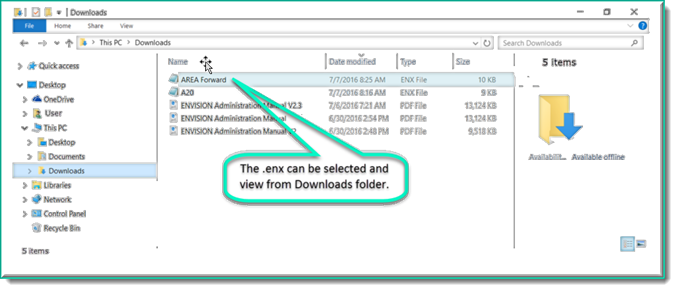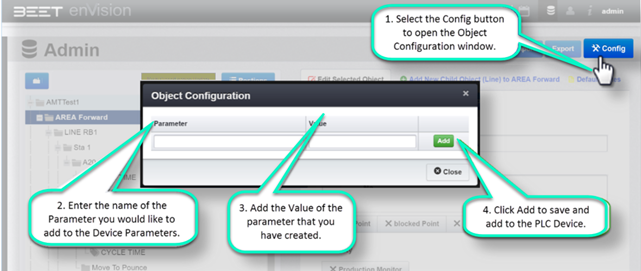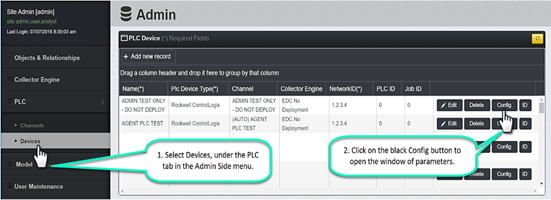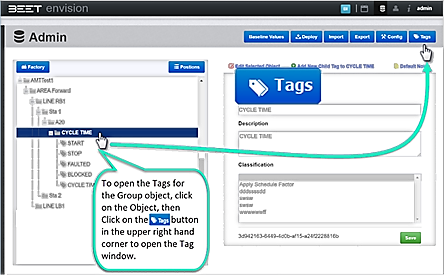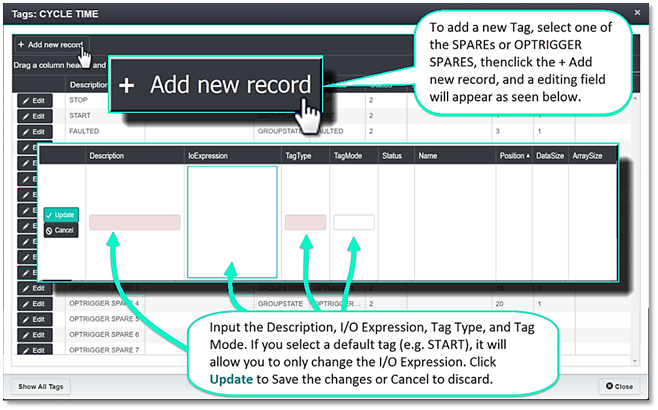Exporting
The Export button is a feature that allows you to export an object from a Plant level to a Group level. First, select the object you would like to Export (e.g. 1AREA Forward ). Now select the Export button. A green Notice window will open, showing that the Export has been initiated. A few moments later, a download dialog window will open on the lower left-hand side of the browser window. Select open to view the.enx file or view it in the Downloads folder.
Configurations
In the event of new installations, it may be needed that the Parameters used in the PLC may require a modification or a change to make it function correctly. For that, there is the blue @ Config button. The Config button is used to add Parameters for the Device section of the PLC. First, select the @ Config button on the upper right side of the browser window. An Object Configuration window will appear. Input the Parameter (name) and the Value for the created parameter. Then click the Add button.
Go to the side menu and select Devices under the PLC tab. This will open the PLC Device page, which will list all the PLC Devices that are in the system currently. To view the created parameter, click on the Config button to open a window of the parameter for the selected PLC Device.
Sometimes an installed PLC device needs to have modified parameters to work correctly or to be tuned to the PLC. To make changes or modify a parameter you can use the! Edit button.
Click the Edit button to open the Device Config. Window.
That will open an editing box for the parameter that has been selected. You can now make a change to the parameter to fine-tune the parameter for a specific PLC Device.
I/O Expressions and Code Explanation
AssetStart
This bit is handled by the Cycle Time Group AOI (Add-On Instructions) and acts as an echo of the Cycle Time Group Start.
The Groups after the Cycle Time Group belonging to the same Asset will see the actual state of the AssetStart bit in the same PLC scan (only in the cases where AssetStart is used in any Group IO Expression), however, since the Asset is scanned before the Cycle Time Group, it will take one more scan for the Asset to see the transitions of the AssetStart bit.
AssetStarted
This bit is handled by the Cycle Time Group AOI, and it is turned on when an idle (stopped) group is started by the Cycle Time Group Start and turned off on the Cycle Time Group Stop.
The Groups after the Cycle Time Group belonging to the same Asset will see the actual state of the AssetStarted bit in the same PLC scan (only in the cases where AssetStarted is used in any Group IO Expression), however, since the Asset is scanned before the Cycle Time Group, it will take one more scan for the Asset to see the transitions of the AssetStarted bit
AssetStartOS
This bit is handled by the Cycle Time Group AOI, it is turned on when the Cycle Time Group goes from not started to Started, stays on for one PLC scan, and then turned off.
The Groups after the Cycle Time Group belonging to the same Asset will see the actual state of the AssetStartOS bit in the same PLC scan (only in the cases where AssetStartOS is used in any Group IO Expression), however, since the Asset is scanned before the Cycle Time Group, it will take one more scan for the Asset to see the state of the AssetStartOS bit
AssetRunning
This bit is handled by the Cycle Time Group AOI, and it is turned on together with the Cycle Time Group Started bit and turned off when the Cycle Time Group Op0 is triggered.
The Groups after the Cycle Time Group belonging to the same Asset will see the actual state of the AssetRunning bit in the same PLC scan (only in the cases where AssetRunning is used in any Group IO Expression), however, since the Asset is scanned before the Cycle Time Group, it will take one more scan for the Asset to see the transitions of the AssetRunning bit"
AssetDone
This bit is handled by the Cycle Time Group AOI, and it is turned when the Cycle Time Group Op0 is triggered and turned off on the Cycle Time Group Stop.
The Groups after the Cycle Time Group belonging to the same Asset will see the actual state of the AssetDone bit in the same PLC scan (only in the cases where AssetDone is used in any Group IO Expression), however, since the Asset is scanned before the Cycle Time Group, it will take one more scan for the Asset to see the transitions of the AssetDone bit.
AssetStop
This bit is handled by the Cycle Time Group AOI and acts as an echo of the Cycle Time Group Stop.
The Groups after the Cycle Time Group belonging to the same Asset will see the actual state of the AssetStop bit in the same PLC scan (only in the cases where AssetStop is used in any Group IO Expression), however, since the Asset is scanned before the Cycle Time Group, it will take one more scan for the Asset to see the transitions of the AssetStop bit.
AssetStopOS
This bit is handled by the Cycle Time Group AOI, and it is turned on when a STARTED Cycle Time Group is stopped, stays on for one PLC scan, and then turned off.
The Groups after the Cycle Time Group belonging to the same Asset will see the actual state of the AssetStopOS bit in the same PLC scan (only in the cases where AssetStopOS is used in any Group IO Expression), however, since the Asset is scanned before the Cycle Time Group, it will take one more scan for the Asset to see the state of the AssetStopOS bit
AssetMem
This bit is handled by the Asset AOI, it is turned on by the Asset SetUserMem Entry and turned off on either the AssetStop or the Asset ResetUserMem Entry.
All Groups after the Asset AOI belonging to the same Asset will see the actual state of the AssetMem bit in the same PLC scan (only in the cases where AssetMem is used in any Group IO Expression), however, if the AssetMem is used in any IO Expression of the same Asset, it will take one more scan for the AssetMem to show transitions
GroupStarted
This bit is handled by the Group AOI, it is turned on when an idle (stopped) group is started by the Group Start and turned off on the Group Stop.
If the GroupStarted bit is used in any IO Expression of the same Group, it will take one more scan for the GroupStarted to show transitions for those IO Expressions.
GroupStartOS
This bit is handled by the Group AOI, it is turned on when the Group goes from not started to Started, stays on for one PLC scan, and then turned off.
If the GroupStartOS bit is used in any IO Expression of the same Group, it will take one more scan for the GroupStartOS to show transitions for those IO Expressions.
GroupRunning
This bit is handled by the Group AOI, it is turned on together with the Group Started bit and turned off when all the configured Ops in the Group are triggered.
If the group running bit is used in any IO Expression of the same Group, it will take one more scan for the GroupRunning to show transitions for those IO Expressions.
GroupDone
This bit is handled by the Group AOI, it is turned when all the configured Ops in the Group are triggered and turned off on the Group Stop.
If the GroupDone bit is used in any IO Expression of the same Group, it will take one more scan for the GroupDone to show transitions for those IO Expressions.
GroupOccurCount
This byte is handled by the Group AOI, it counts up when on the GroupDone and reset on the AssetStopOS.
If the GroupOccurCount bit is used in any IO Expression of the same Group, it will take one more scan for the GroupOccurCount to show changes for those IO Expressions.
GroupStopOS
This bit is handled by the Group AOI, it is turned on when a STARTED Group is stopped, stays on for one PLC scan, and then turned off.
If the GroupStopOS bit is used in any IO Expression of the same Group, it will take one more scan for the GroupStopOS to show transitions for those IO Expressions."
GroupMem
This bit is handled by the Group AOI, it is turned on by the Group UserMem Entry and turned off on either the GroupStop.
If the GroupMem bit is used in any IO Expression of the same Group, it will take one more scan for the GroupMem to show transitions for those IO Expressions.
Envision IO Expression Shortcuts
Asset Status bits
Shortcut (Not Case Sensitive) |
Description |
ASSETMEMORY or ASSETMEM |
This is turned on by the Asset SetUserMem Entry and turned off by either the AssetStop or the Asset ResetUserMem Entry. All Groups that belong to the same Asset use the same AssetMem. |
ASSETSTART |
This is an echo of the CycleTime group's START conditions. All Groups that belong to the same Asset use the same AssetStart. |
ASSETSTARTOS |
This is a one-time trigger set on the first OFFàON transition of the CycleTime group START following a STOP. All Groups that belong to the same Asset use the same AssetStartOS. |
ASSETSTOP |
This is an echo of the CycleTime group's STOP conditions. All Groups that belong to the same Asset use the same AssetStop. |
ASSETSTOPOS |
This is a one-time trigger set on the first OFFàON transition of the CycleTime group STOP following a START. All Groups that belong to the same Asset use the same AssetStopOS. |
ASSETSTARTED |
This is turned on when an idle (stopped) Asset is started by the Cycle Time Group Start and turned off on the Cycle Time Group Stop. All Groups that belong to the same Asset use the same AssetStarted. |
ASSETRUNNING |
This is turned on together with AssetStarted and turned off when the Cycle Time Group Op0 is triggered. All Groups that belong to the same Asset use the same AssetRunning. |
ASSETDONE |
This is turned on when a STARTED Cycle Time Group Op0 is triggered and turned off on the Cycle Time Group Stop. All Groups that belong to the same Asset use the same AssetDone. |
Group Status bits
Shortcut (Not Case Sensitive) |
Description |
GROUPMEMORY or GROUPMEM |
This is turned on by the Group SetUserMem Entry and turned off by the GroupStop Entry |
GROUPSTARTOS |
This is a one-time trigger set on the first OFFàON transition of the Group START following a STOP. |
GROUPSTARTED |
This is turned on when an idle (stopped) group is started by the Group Start and turned off on the Group Stop. |
GROUPRUNNING |
This is turned on together with GroupStarted and turned off when all configured Group OPs are triggered. |
GROUPDONE |
This is turned on when all configured OPs of a STARTED Group are triggered and are turned off by the Group Stop. |
GROUPSTOPOS |
This is a one-time trigger set on the first OFFàON transition of the Group STOP following a START. |
Group Tag Explanation
At the Group level, every object has a tag that can be configured to what you need it to achieve. To view and configure these Group Tags, you need to select the group object you wish to view. In the upper right-hand corner is the Tags Button.
The Tags: (CYCLE TIME) window will open and display the default parameters associated with that object selected. Whenever a Group object is created, these Standard Tags are automatically attached to the Group objects created.
There are more Tags available for you to utilize. Simply click on the Show All Tags- button, located on the lower left side of the Tags Window.
The Tags window will now update with all the available tags to be utilized as needed. The tags provided, are additional labeled Spare 4-15 and OPTRIGGER SPARES 1-16. You can also add a new Tag by selecting the + Add new record button. Fill out the parameter fields and click the update button.
The Column headers can be dragged and dropped to sort the tags by the header selected. Simply click and hold the column header, then drag it up to the column field above the headers and then release. It will now sort the tags by the selected header field. They also can be sorted by ascending or descending, by simply clicking on the Column Header icon.
Add New Record
If another tag needs to be created or needs to be edited, you can select a tag from the list (SPARES or OPTRIGGERS SPARES), then click the + Add new record. The selected window will expand into an editing field to make you changes. Under the Description, input a name to represent the tag. Input the I/O expression, Tag type, and Tag Mode. If everything is set and ready, click the Update button, to save changes or Cancel to discard changes and go back to the list. If you want to change the I/O Expression only, you can select the Edit button and the selected tag will open an editing box to make your changes. When finished, click update to Save or Cancel to discard changes.
Group Tag Definitions
START
START is used to indicate that the step has been initiated. Solenoid valves, robot initiate, operator clear to enter, etc. are examples of common Start signals. The START signal is a retentive signal and goes true upon the first OFF / ON transition. It is not reset until the Group STOP signal goes true. The Envision PLC driver stores the current Timestamp during the scan that the transition is detected.
STOP
STOP is used to reset the Group and clear all retentive signals and memory bits in the PLC driver that are associated with that Group. The only Group that MUST have an expression entered for its STOP signal is the CYCLE TIME Group. This STOP signal has special meaning to the Envision application. It turns on the Asset Stop signal inside the PLC driver that indicates to Envision that an Asset has completed a cycle and that all the data captured by the application since the Start of the Asset can be processed and stored as historical data. All Groups other than the CYCLE TIME Group have the option of leaving the STOP signal blank. The Deploy function that generates the PLC driver logic is designed to automatically use the Asset Stop signal to fill in any Group STOP signal that is left blank. It is strongly recommended to leave Group STOP signals blank IF the Group is expected to occur only once per cycle. This ensures that all Groups get reset at the end of a cycle.
There are a couple of exceptions touched upon earlier where it may be desirable to capture multiple occurrences of a Group during one cycle of an Asset such as monitoring how many times an operator moves in and out of a light screen and the gaps between each occurrence. For this scenario, it is necessary to enter an expression for the STOP signal in order for the Group to reset before the cycle ends.
FAULTED
The object is faulted and stops working.
BLOCKED
The object completes its work and is waiting for downstream objects to finish so the finished part can move out of the object.
CYCLETIME
Amount of time between the start and stop of an object.
SPARES (4-15)
The Spares are used to create custom Group Tags when you are required to have more than the default tags.
OPTRIGGER SPARE (1-16)
The OPTRIGGER SPARE is used to create a custom Op Trigger
Asset Tag Explanation s
AUTO
The object is in a full auto or normal operation mode.
MANUAL
The Asset is running manually or being engaged for a maintenance or troubleshooting mode.
FAULTED
Tooling or Automation failure, that may require manual intervention.
BLOCKED
The Asset has finished its work and cycle, but cannot transfer its finished product to the next position.
PRIMARY STARVED
The overall time the object is in a Starved state. The object completed its job and the produced part has exited the object. The object is waiting for the next part to start working.
RUNNING
The Asset is performing its designed functionality
IDLE
The asset has done its function.
SECONDARY STARVED
The system is waiting for parts that are loaded at this asset.
INTERRUPTED
An asset cycle is interrupted due to violation of safety setup or other non-tooling and automation related stoppage.
NON-PRODUCTION
The system is not engaged or not in production. During this time, no records will be kept.
USER 01-04
SPARE 11-27
The Spares are used to create custom Asset Tags.

